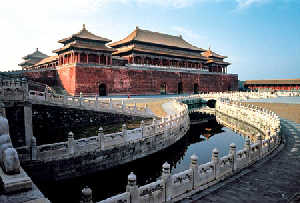
The Forbidden City
Ancient Chinese architecture styles vary greatly, depending on the social class an individual owner belonged to. For instance, totally different from the commoner architecture, the Forbidden City -- the most magnificent Quadruple in China -- is a typical example of imperial omnipotence.
Imperial Palaces
The imperial palace of ancient China is a miracle in world architectural history. Take the Forbidden City for example, especially concerning its use of colors. Since yellow is the imperial color, the most noticeable are the yellowrooftiles, while the wooden columns of the buildings as well as the surface of the walls are red in color.
Another important feature of the Forbidden City is its emphasis on symmetry, which connotes a sense of grandeur. Even the style of the roof shows the power of the sovereign, with the ridges engraved with the immortal or beasts symbolizing stateliness.
The overall arrangement of the Forbidden City accords with traditional Chinese ritual requirements and the Yin-Yang Principle. It boasts five distinctive features:
First, the front part is a place for the emperor to handle official businesses, and the rear part is the residence for emperors and concubines.
Second, within the complex there are several immense courtyards divided by individual gates.
Third, there is a shrine for the ancestors in the east and another one for the agricultural deities in the west.
Fourth, the structure is symmetrical.
Finally, in addition to the palaces, there is still a fabulous garden for the imperial family to relax themselves.

Copyright ©1999-2011 Chinanews.com. All rights reserved.
Reproduction in whole or in part without permission is prohibited.